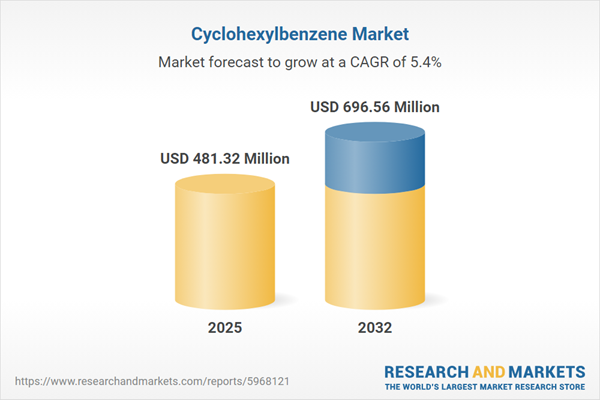Speak directly to the analyst to clarify any post sales queries you may have.
The Cyclohexylbenzene market is experiencing rapid shifts as organizations across the value chain embrace new technologies and adapt supply models for greater efficiency. As industry dynamics evolve, senior decision-makers require actionable insights to navigate strategic challenges and secure business resilience in a changing market landscape.
Market Snapshot: Cyclohexylbenzene Market Overview
The Cyclohexylbenzene market exhibits substantial growth momentum, propelled by advancements in catalyst technologies and a shift towards streamlined, agile supply chains. Strategic alliances among leading players are driving the development of sustainable practices that keep regulatory compliance at the forefront. Efforts to set clearer operational standards and promote transparent stakeholder engagement are reinforcing the sector's competitive position globally. The integration of technology across regions supports both mature and emerging markets, fostering an environment of trust and sustainable partnerships.
Scope & Segmentation
- Applications: Utilized in adhesives and sealants for improved structural integrity and pressure sensitivity. Used in automotive and industrial coatings to enhance performance, extend the operational lifespan of lubricant additives for engine oils and hydraulic fluids, and act as a plasticizer in PVC-based products to strengthen durability across industrial and consumer goods.
- End Use Industries: Supports material stability in automotive manufacturing, improves construction results in both new projects and renovations, boosts long-term product performance in electrical and electronic manufacturing, and preserves goods integrity throughout logistics and food packaging sectors.
- Purity Grades: High-purity solutions serve specialized industrial needs. Standard grades fulfill laboratory and general industrial requirements, while technical grades are tailored for consistent project-specific value.
- Sales Channels: Access to the market is established through direct procurement and distributor networks, including both traditional supply and digital procurement options, ensuring responsive customer support and flexibility for commercial buyers.
- Regions: Active across the Americas, Europe, Asia-Pacific, and the Middle East & Africa, the market applies localization strategies to meet both regulatory and distinct regional requirements, opening opportunities across diverse economies.
- Key Players: BASF SE, China Petroleum & Chemical Corporation, Evonik Industries AG, Dow Inc., Eastman Chemical Company, Saudi Basic Industries Corporation, INEOS Group Holdings S.A., Covestro AG, LANXESS AG, and Arkema S.A. focus on reliable supply, integrated technology platforms, and innovation, supporting ongoing market development and sustainability.
Cyclohexylbenzene Market: Key Takeaways
- Continuous improvements in specialty chemical manufacturing are boosting efficiency and reliability, thus ensuring stability across evolving supply chain requirements.
- The use of renewable feedstocks is advancing sustainability efforts, supporting stakeholder expectations around environmental stewardship and aligning with global responsibility goals.
- Product customization and swift adaptation to changes in downstream market demands are helping suppliers capture emerging opportunities and broaden their commercial reach.
- The rise of digital procurement and e-commerce platforms is enhancing overall supply network responsiveness and supporting long-term risk management strategies.
- Cross-regional collaboration and adaptive manufacturing approaches are improving the market's capacity to mitigate disruptions and rapidly respond to industry shifts across continents.
Tariff Impact
Recent changes to U.S. tariffs have increased sourcing costs and affected supplier relationships, leading organizations to diversify suppliers, reinforce domestic production, and implement flexible contracts. Emphasizing modular plant designs and advanced logistics now plays a crucial role in maintaining operational continuity amid regulatory changes.
Methodology & Data Sources
This analysis applies comprehensive secondary research and targeted industry interviews, following current best practices. The methodology ensures the reliability and relevance of trend analysis and market structure assessments, making the findings robust for strategic decision-making and compliance reviews.
Why This Report Matters
- Provides executives with benchmarking tools for both new and existing technologies within the Cyclohexylbenzene sector, reinforcing procurement processes and improving risk management frameworks.
- Prepares stakeholders to anticipate regulatory developments and respond proactively to structural adjustments across markets.
- Delivers actionable intelligence to support digital transformation and sustainability initiatives, enabling leaders to maintain a competitive edge in a shifting industrial environment.
Conclusion
Up-to-date Cyclohexylbenzene market intelligence enables organizations to strengthen agility, fortify supply networks, and manage industry transitions confidently.
Additional Product Information:
- Purchase of this report includes 1 year online access with quarterly updates.
- This report can be updated on request. Please contact our Customer Experience team using the Ask a Question widget on our website.
Table of Contents
3. Executive Summary
4. Market Overview
7. Cumulative Impact of Artificial Intelligence 2025
Companies Mentioned
The companies profiled in this Cyclohexylbenzene market report include:- BASF SE
- China Petroleum & Chemical Corporation
- Evonik Industries AG
- Dow Inc.
- Eastman Chemical Company
- Saudi Basic Industries Corporation
- INEOS Group Holdings S.A.
- Covestro AG
- LANXESS AG
- Arkema S.A.
Table Information
| Report Attribute | Details |
|---|---|
| No. of Pages | 192 |
| Published | November 2025 |
| Forecast Period | 2025 - 2032 |
| Estimated Market Value ( USD | $ 481.32 Million |
| Forecasted Market Value ( USD | $ 696.56 Million |
| Compound Annual Growth Rate | 5.4% |
| Regions Covered | Global |
| No. of Companies Mentioned | 11 |









